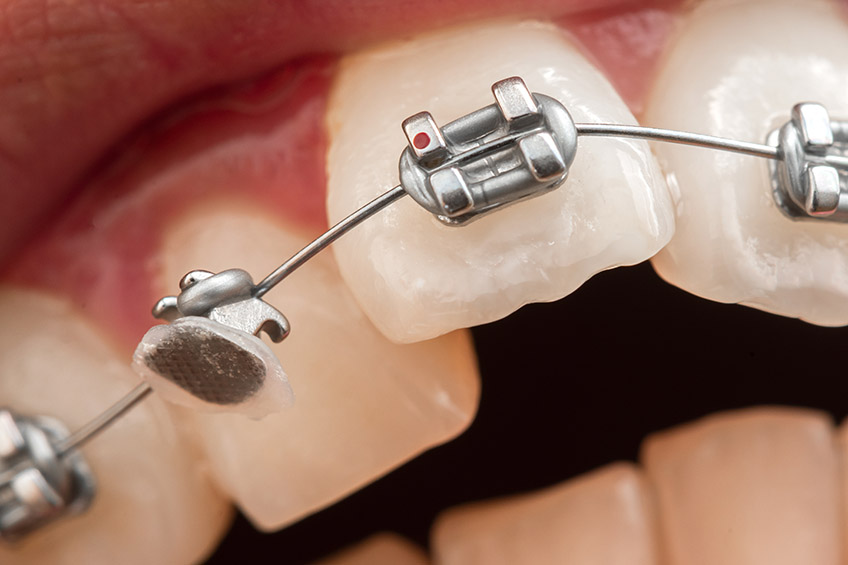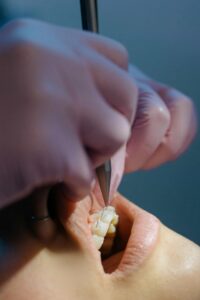Ever felt like you’re just one bite away from a braces mishap? If you’ve ever heard that dreaded “snap” while enjoying your favorite snack, you know the mini heart attack that follows isn’t far behind. Suddenly, you’re Googling “broken braces bracket” and “broken wire braces” like it’s your job, wondering how on earth you’re going to navigate this dental dilemma.
At A Winning Smile Orthodontics, we’ve seen our fair share of orthodontic adventures and understand that accidents happen. Whether it’s a broken bracket from an innocent popcorn encounter or a wire that’s decided to go rogue during dinner, we’re here to tell you there’s no need to panic. With the right know-how and a bit of humor, managing a braces emergency can be as smooth as your soon-to-be straightened teeth.
In this article, we’ll walk you through the ins and outs of dealing with broken brackets and wires—what to do, how to do it, and when to call in the cavalry (aka your orthodontist). So, let’s dive in and turn that braces blunder into a stress-free fix!
Recognizing a Broken Bracket or Wire
Identifying a broken bracket or wire in your braces setup isn’t quite like finding Waldo, but it does require you to pay close attention to your mouth’s hardware. Here’s how to spot the signs of orthodontic rebellion before it turns into a full-blown discomfort fest.
For the Broken Bracket Brigade: A bracket, essentially the braces’ basecamp attached to each tooth, can become loose or break off completely. If you notice a bracket that’s sliding along the wire or hanging out in your mouth without a clear purpose, congratulations—you’ve got a broken bracket. Sometimes, it’s still partially attached to the wire, which keeps it from getting lost but also doesn’t let it do its job.
And the Wayward Wire Wanderers: A broken wire in your braces can feel like suddenly finding an uninvited dental dance partner poking, prodding, or even scratching the inside of your mouth. If you spot a wire sticking out at an odd angle or feel it jabbing you, you’ve encountered the broken wire dilemma. These breakages can range from a small protrusion to a full-on wire displacement, depending on the break’s nature.
Symptoms to Watch For: Besides the visual cues, you might experience discomfort, irritation, or even pain if a broken component is making unscheduled contact with your mouth’s soft tissues. Increased difficulty with eating or speaking clearly can also be tell-tale signs that something’s amiss in your orthodontic apparatus.
Recognizing these issues early on is crucial. The sooner you identify a broken bracket or wire, the quicker you can address it, minimizing discomfort and avoiding potential delays in your treatment progress. Remember, your braces are a team of tiny champions straightening your smile, and even one player down can affect the whole game.
Immediate Steps to Take
When you discover a broken bracket or wire, think of it as a minor detour on your road to a perfect smile, not a full stop. Here are some immediate steps to take that can help you navigate this hiccup safely and comfortably until you can see your orthodontist.
Don’t Panic
First and foremost, keep calm. Orthodontic issues, including broken brackets and wires, are common and typically not emergencies that endanger your health. However, they do require prompt attention to keep your treatment on track and to avoid discomfort.
Assess the Situation
Take a close look to understand exactly what’s happened. Is it a broken wire causing discomfort, or has a bracket come loose? Knowing what you’re dealing with will help you communicate with your orthodontist’s office more effectively.
Temporary Fixes
For a broken wire, if it’s poking you, try using the eraser end of a pencil to gently push it back into a less bothersome position. If that’s not possible, orthodontic wax can be your best friend. Roll a small piece into a ball and flatten it over the offending wire or bracket to create a smooth barrier between the metal and your mouth.
In the case of a broken bracket, if it’s still attached to the wire but causing irritation, again, orthodontic wax is a great temporary solution. If the bracket has completely detached, store it in a safe place and bring it to your orthodontist appointment.
Clean the Area
Whether it’s a broken bracket or wire, keep the area clean to prevent any irritation or infection. Continue to brush gently around the damaged parts and use mouthwash to keep everything as clean as possible.
Call Your Orthodontist
Contact A Winning Smile Orthodontics or your orthodontic practice as soon as possible. Explain the situation, and they’ll advise you on the next steps. They may offer advice over the phone or schedule an appointment to fix the issue.
Remember, while these immediate steps can help alleviate discomfort and prevent further issues, professional repair by your orthodontist is necessary to ensure your treatment continues effectively. So, while you’ve got this temporary fix in place, make sure to follow up with your orthodontic team promptly.
Contacting Your Orthodontist
After you’ve managed the initial shock of a broken bracket or wayward wire and applied a temporary fix, the next critical step is to contact your orthodontist. This isn’t just about fixing a piece of metal; it’s about keeping your smile journey on the right path.
Make the Call Sooner Rather Than Later: As soon as you realize you’ve got a broken braces bracket or a rogue wire, give your orthodontist’s office a ring. Don’t wait until your next scheduled appointment to mention it. These issues can affect the progress of your treatment and may even prolong it if left unaddressed.
Be Prepared to Describe the Issue: When you call, be ready to explain what happened and what part of the braces is affected. Is it a broken bracket? A wire poking out? The more details you can provide, the better prepared your orthodontic team will be to help you when you come in.
Ask for Advice: Your orthodontist’s team can offer guidance on any further steps you should take before your appointment. They might have additional tips for managing discomfort or keeping your braces intact until they can see you.
Schedule an Appointment: The office will likely schedule a repair appointment for you as soon as possible. These appointments are often treated as priorities, given the importance of maintaining the integrity of your orthodontic treatment.
Follow Any Provided Instructions: If your orthodontist gives you specific advice over the phone, make sure to follow it closely. They know your orthodontic situation best and can provide tailored advice to ensure your comfort and treatment progress.
Remember, A Winning Smile Orthodontics and most orthodontic practices are well-versed in handling broken brackets and wires. They understand these are common occurrences in the braces journey and are there to help you navigate these minor bumps in the road. Keeping open communication with your orthodontist ensures that your treatment stays on track, and you continue moving forward towards that perfect smile.
Professional Repair and Treatment Adjustment
Once you’ve made contact with your orthodontist and scheduled an appointment, the path to repair begins. Here’s what you can expect during your visit for professional repair and potentially some treatment adjustment, ensuring your journey to a perfect smile doesn’t hit a prolonged detour.
Professional Repair
Upon arrival, your orthodontist will assess the situation to understand the extent of the damage. This might involve a brief examination and possibly some imaging to see if the break has affected your treatment progress.
For a broken bracket, the process generally involves removing the damaged piece entirely and replacing it with a new one. Your orthodontist will carefully reattach the bracket to your tooth, ensuring it’s positioned correctly to continue your treatment effectively.
Dealing with a broken wire can be a bit simpler. Often, the orthodontist can trim the damaged part of the wire or replace it entirely. Adjustments will be made to ensure the wire’s tension is correct for your treatment plan, keeping your teeth moving in the right direction.
Treatment Adjustment
Sometimes, a break can be a signal that your treatment needs a slight adjustment. Your orthodontist will take this opportunity to reassess your progress and make any necessary changes. This might involve adjusting the tension on your braces, changing the configuration of your brackets, or even discussing alternative treatment options if the breakage is a symptom of a larger issue.
This appointment is also a great time to address any concerns or discomfort you’ve been experiencing with your braces. Open communication with your orthodontist is key to a smooth and effective treatment process.
Aftercare
Before you leave, your orthodontist will provide you with aftercare instructions to ensure proper healing and adjustment to the repair. This might include advice on managing discomfort, dietary recommendations to avoid further damage, and tips on oral hygiene practices to keep your braces and teeth clean.
Remember, the goal of this appointment is not just to fix a broken wire or bracket but to ensure your overall treatment remains on track. Professional repair and timely adjustments are crucial elements of successful orthodontic treatment. With the expert care of your orthodontist, you’ll be back on your way to achieving your dream smile, equipped with the knowledge and confidence to handle any minor setbacks along the journey.
Preventing Future Breaks
While navigating the braces journey, encountering a broken bracket or wire can feel like a rite of passage. However, there are proactive steps you can take to minimize the chances of an encore performance of orthodontic mishaps. Here’s how you can play defense against future breaks and keep your treatment cruising smoothly towards that winning smile:
Mind Your Meals: One of the leading causes of broken braces components is chomping down on foods that are just too tough for your hardware to handle. Stick to braces-friendly foods that are soft and easy to chew. Say a temporary goodbye to crunchy, hard, sticky, or chewy treats that can apply unwanted pressure on brackets and wires. When in doubt, cut food into smaller, manageable pieces.
Practice Stellar Oral Hygiene: Keeping your braces and teeth clean reduces the risk of complications that could lead to broken components. Use a soft-bristled toothbrush, fluoride toothpaste, and floss threaders or a water flosser to navigate around braces. This not only keeps your mouth healthy but also ensures your braces can do their job without interference from plaque buildup or decay.
Wear a Mouthguard for Sports: For the athletes out there, protecting your braces (and teeth) during physical activity is a must. A properly fitted mouthguard can be a braces wearer’s best friend, safeguarding against impacts that could lead to broken brackets or wires.
Follow Your Orthodontist’s Advice: If your orthodontist has recommended rubber bands or other orthodontic appliances, use them as directed. Incorrect use or neglecting these tools can put undue stress on your braces, leading to breakages. Plus, following instructions to the letter ensures your treatment progresses as efficiently as possible.
Regular Check-Ups: Keeping up with your scheduled orthodontic appointments allows your orthodontist to catch potential issues before they turn into breakage emergencies. These check-ups are the perfect time to address any concerns you have about your braces feeling loose or uncomfortable.
Brace for Impact: Accidents happen, and if you find yourself in a situation where your braces might be at risk (think high-contact sports, adventurous eating, or even a curious nibble on a pen), consider how you can protect your orthodontic investment. Sometimes, a bit of foresight can prevent the break in the first place.
By following these preventative measures, you not only reduce the risk of experiencing broken brackets or wires but also contribute positively to the overall success of your orthodontic treatment. And remember, if you do face an orthodontic hiccup, your orthodontist is your best resource for advice, repair, and encouragement. Together, you’ll keep your treatment on track, paving the way to a straighter, healthier smile.
Conclusion
Facing a broken bracket or wire during orthodontic treatment can seem daunting, but it’s a manageable part of the journey toward a stunning smile. Remember, the key is not to panic but to act swiftly and communicate with your orthodontist. These incidents are merely bumps on the road to achieving your smile goals, not full stops.
We’ve explored how to handle these common issues and preventative steps to minimize their occurrence. Keeping a cool head and following your orthodontist’s guidance can turn these challenges into mere footnotes in your orthodontic journey. So, should you encounter a hiccup, take it in stride. Your dream smile, free of orthodontic adventures, is on the horizon, and every step, even those involving a bit of repair, is bringing you closer to that moment of unveiling.





